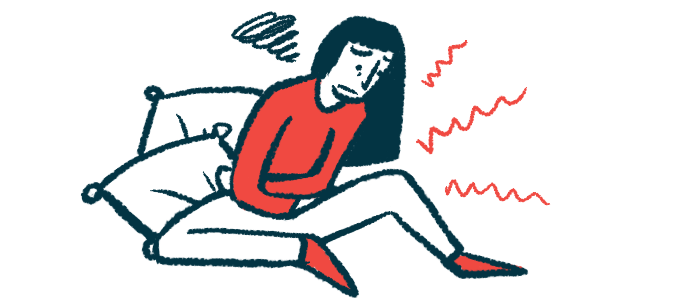No Recurrent AIP Attacks With Givlaari, Small Real-world Study Reports
Written by |

Almost all people with severe, recurrent acute intermittent porphyria (AIP) were free from symptomatic attacks after treatment with Givlaari (givosiran), a small real-world study showed.
Givlaari “drastically reduced the attack rate in our cohort, as 96% were attack-free at the time of the study,” the researchers wrote.
Early treatment resulted in significantly better responses, allowing for a decrease in dosage in some patients.
However, the study also confirmed the high prevalence of adverse events, “most of which are benign but could impair the patient’s quality of life, such as the frequently reported fatigue and nausea,” the team wrote.
Thus, they suggested that the impact of Givlaari on urinary heme metabolites should be monitored monthly to allow for dose adjustments and an individual approach to treatment.
The study, “Givosiran in acute intermittent porphyria: A personalized medicine approach,” was published in the journal Molecular Genetics and Metabolism.
AIP is caused by a genetically inherited deficiency in HMBS, an enzyme that helps in the production of heme, a molecule that is essential for oxygen transport in the body.
Although most people who carry HMBS mutations do not develop symptoms, acute attacks can occur due to the activation of an associated enzyme called ALAS1. This can be triggered by hormonal changes, infections, alcohol consumption, smoking, reduced caloric intake, and stress.
Activated ALAS1 results in the buildup of two heme precursors — delta-aminolevulinic acid (ALA) and porphobilinogen (PBG) — in the liver, triggering symptoms like abdominal pain with nausea and vomiting, and in severe cases, seizures, states of confusion, and hallucinations.
Most patients will experience one or a few attacks in a lifetime, but less than 10% will develop recurrent symptoms. AIP patients and mutation carriers also are known to be at an increased risk of developing high blood pressure, and kidney and liver disease.
Givlaari, a therapy developed by Alnylam Pharmaceuticals that’s designed to suppress ALAS1, was recently approved for porphyrias that affect the liver, including AIP. In clinical trials, patients treated with monthly subcutaneous (under-the-skin) injections had significantly fewer acute attacks and lower levels of ALA and PBG in the urine.
In this report, researchers at the University of Paris, along with collaborators at various sites across France, described the impact of Givlaari in 24 AIP patients, in which dosing frequency was adjusted based on individual ALA levels throughout the course of their treatment.
“We decided to evaluate a personalized medicine approach based on each patient’s ALA level and to perform an individual follow-up,” the team wrote.
Eligible AIP patients experienced four or more attacks per year and/or were being treated with heme arginate, a medication that suppresses porphyrin production, on a preventive basis. They initially received 2.5 mg/kg of Givlaari each month, regardless of early response, and were treated and followed for a median of 16 months (one year, three months).
At the time of the analysis, Givlaari led to a sustained overall reduction in urinary ALA levels, which dropped by a median of 89.9%. Notably, 23 of the 24 participants (95.8%) did not experience an acute attack.
Before treatment, the levels of urinary ALA ranged from 7.9 to 51.4 micromole per millimole (mcmol/mmol) of creatinine — way above the normal maximum of 3 mcmol/mmol creatinine. Of note, ALA values are normalized to creatinine concentrations to account for differences in urine volume.
After treatment with Givlaari, 20 patients (83%) had consistently under 5 mcmol/mmol creatinine, and among these, some measurements were below 3 mcmol/mmol creatinine. The remaining four individuals showed a moderate decrease in ALA levels.
One female participant (patient 9) showed a limited (78.1%) and variable decrease in ALA, which never dropped below 5 mcmol/mmol creatinine. She regularly experienced attacks requiring heme arginate every four or six weeks and received opioids to manage her daily abdominal pain. Three other patients with a partial response — a drop of 51.5% to 76.9% in ALA levels — no longer had acute attacks.
Statistical analysis showed a significant positive association between the year of AIP onset and ALA level percent reduction, demonstrating that “treatment efficacy was better in patients with the shortest duration of disease course,” the researchers wrote.
Clinicians adjusted the frequency of Givlaari dosing based on monthly ALA measurements, which led to two distinct groups of patients: 14 (58%), who required Givlaari every three months or more frequently, due to moderate or unstable drops in ALA levels; and 10 (42%) who were treated less frequently and maintained low ALA levels.
“The heterogeneity [variability] of individual responses over time strongly supports that personalized therapeutic adaptation is necessary,” the researchers wrote.
Among those who required more frequent treatment, there was either a moderate ALA decrease or a rapid increase after initiating Givlaari. There was an overall 82.8% drop in ALA levels under treatment in this group, with a mean ALA level of 5.6 mcmol/mmol. Six of these patients were treated every two to three months, while eight received therapy every four to six weeks.
Patients treated less frequently had an overall reduction of 95.6% in ALA levels, which were sustained at a mean of 1.4 mcmol/mmol. Dosing frequency ranged from four to 14 months (median of 7.5 months), which was only scheduled when ALA levels increased. These individuals did not experience acute symptoms while under Givlaari.
A higher injection frequency was more likely in those who experienced acute symptoms for a more extended period of time. Consistently, there was a significant difference in the mean number of years since disease onset between patients requiring less or more frequent treatments (6.7 vs. 19.6 years).
All participants reported at least one adverse event. Elevated ALT levels, a sign of liver damage, were documented in eight patients (32%), which occurred in the first six months of treatment in every case but one. Fatigue was experienced in 17 (68%), nausea in 10 (40%), and six (24%) increased hair loss and/or spontaneous nail loss.
A moderate and short-lived increase in blood creatinine levels, a sign of kidney function impairment, was seen in 91% of the patients. High levels of homocysteine, which can damage blood vessels, were present in all 23 patients with measurements. Homocysteine levels tended to rise with treatment (median increase of 305%).
One patient had a serious adverse event leading to study withdrawal after four months due to acute pancreatitis, a sudden inflammation of the pancreas. Treatment of another patient was interrupted for 2.5 months due to a marked increase in markers for pancreatitis, then resumed at a lower dose without relapse. Other serious adverse events included high levels of liver enzymes, pulmonary embolism, and kidney function decline.
“In our cohort under [Givlaari] treatment, all but one (95.8%) severe AIP patient, as defined by 4 or more acute attacks by year or requiring prophylactic heme arginate, was free of acute crisis,” the authors wrote. “The long-lasting effect of the treatment in some patients allowed us to reduce the dosing frequency under close surveillance of haem precursor levels without a reduction in biological or clinical efficacy.”
“Early treatment with [Givlaari] was associated with a better biological response and allowed us to decrease the dosing frequency,” they wrote.







